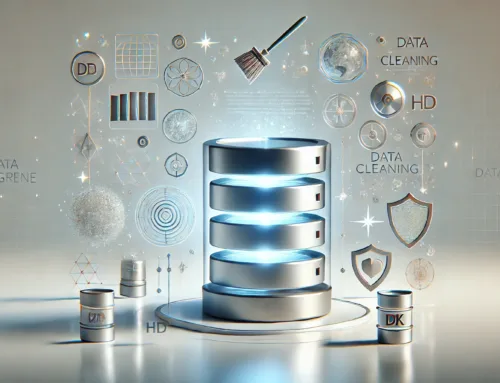You may think data hygiene services are all about cleaning clutter, but there’s more to it. What if I told you that mastering the top 10 success factors could revolutionize your data management strategy? From maintaining quality data to ensuring cost efficiency, each factor plays a crucial role. Let’s explore how these elements can elevate your data hygiene game and pave the way for enhanced business performance.
Quality Data
Quality data is the cornerstone of effective data hygiene services. Data accuracy is essential for ensuring that your databases are up-to-date and reliable. Data cleansing plays a crucial role in maintaining the quality of your data by identifying and correcting any errors, inconsistencies, or duplicates within your datasets.
When it comes to data accuracy, it is vital to regularly validate and verify the information stored in your databases. This process involves cross-referencing data points, checking for outdated records, and ensuring that all entries are complete and error-free. By prioritizing data accuracy, you can enhance the overall reliability and trustworthiness of your data, which is essential for making informed business decisions.
Data cleansing complements data accuracy by actively improving the quality of your datasets. By utilizing data cleansing tools and techniques, you can streamline your databases, remove irrelevant or duplicate entries, and standardize data formats. This process not only enhances data accuracy but also improves the efficiency of your data management practices.
Skilled Team
To ensure the success of your data hygiene services, assembling a skilled team is key. Team training plays a vital role in enhancing the capabilities of your staff. By investing in continuous learning opportunities, you can keep your team up-to-date with the latest trends and technologies in data hygiene practices. This training should cover areas such as data cleansing techniques, compliance regulations, and best practices for maintaining data quality.
Expertise development is another crucial aspect when it comes to building a skilled team for data hygiene services. Encouraging your team members to specialize in specific areas within data hygiene, such as duplicate identification or data standardization, can help maximize their efficiency and effectiveness. Providing avenues for professional growth, such as certifications or attending industry conferences, can further enhance their expertise and contribute to the overall success of your data hygiene efforts.
Advanced Tools
Utilizing advanced tools is essential for optimizing the efficiency and effectiveness of your data hygiene services. When it comes to data enrichment, advanced tools offer capabilities to enhance your existing database with additional information such as demographics, firmographics, and behavioral data. These tools can automatically append missing fields, standardize formats, and validate information to ensure your database is comprehensive and accurate.
In terms of data cleansing, advanced tools provide sophisticated algorithms and machine learning techniques to identify and correct errors, duplicates, and inconsistencies within your dataset. These tools can streamline the process of removing outdated or irrelevant data, ensuring that your database remains up to date and reliable.
Regular Monitoring
With the foundation of your data hygiene services set through the use of advanced tools, the next crucial step is regular monitoring. Data monitoring is essential to ensure that your data remains accurate, up-to-date, and compliant with regulations. By implementing regular monitoring practices, you can identify and rectify any data inconsistencies or errors promptly, preventing potential issues down the line.
Utilizing monitoring tools is key to streamlining this process. These tools can automatically scan your databases for duplicates, incomplete records, or outdated information, saving you time and effort. They can also generate reports that highlight areas needing attention, enabling you to take quick corrective actions.
Regular monitoring not only helps maintain the quality of your data but also enhances the overall efficiency of your data hygiene services. By staying vigilant and proactive in your monitoring efforts, you can stay ahead of potential data quality issues and ensure that your data remains a reliable asset for your business.
Data Privacy & Security
When it comes to data privacy and security, ensuring compliance with privacy regulations is paramount. Secure data handling practices, such as encryption and restricted access, are key to safeguarding sensitive information. Implementing robust cybersecurity measures is essential to protect against data breaches and unauthorized access to valuable data assets.
Privacy Regulations Compliance
To ensure effective data hygiene services, it is crucial to prioritize Privacy Regulations Compliance, specifically focusing on Data Privacy & Security. Compliance with privacy regulations such as GDPR and CCPA is essential for maintaining the trust of your customers and avoiding costly penalties. Implementing data encryption and consent management tools ensures that sensitive information is protected and used appropriately. Anonymization techniques should be employed to remove personally identifiable information from datasets, reducing the risk of data breaches or unauthorized access. Establishing clear data retention policies helps in managing data lifecycle, ensuring that information is not kept longer than necessary. By adhering to these regulations and best practices, you not only safeguard your customers’ data but also demonstrate your commitment to upholding privacy standards. Prioritizing Privacy Regulations Compliance in your data hygiene services is a proactive approach that can mitigate risks and enhance your business reputation.
Secure Data Handling
Effective secure data handling is a fundamental aspect of maintaining data privacy and security in your organization. To ensure secure data handling, implement robust data encryption techniques to safeguard sensitive information from unauthorized access. Utilize data access controls to restrict access to confidential data only to authorized personnel, reducing the risk of data breaches. Secure data storage practices, such as encryption at rest and regular data backups, help protect data integrity and confidentiality.
Additionally, prioritize data transfer security by using secure protocols like HTTPS when transmitting data over networks. Implementing secure file transfer methods, such as SFTP or encrypted email attachments, adds an extra layer of protection during data exchanges. By emphasizing secure data handling practices, you enhance your organization’s data privacy posture and mitigate potential risks associated with unauthorized data access or leakage. Remember, maintaining data security is an ongoing process that requires vigilance and proactive measures to safeguard sensitive information effectively.
Cybersecurity Measures
Cybersecurity measures are critical components of ensuring data privacy and security within your organization. Conducting a thorough risk assessment is essential to identify potential vulnerabilities and threats to your data. By understanding the risks, you can implement targeted cybersecurity measures to mitigate these threats effectively.
Cyber threats are constantly evolving, making it crucial to stay vigilant and proactive in safeguarding your data. Implementing robust cybersecurity measures, such as encryption protocols, multi-factor authentication, and regular security audits, can help fortify your defenses against cyber attacks.
Regularly updating your security protocols and investing in employee training on cybersecurity best practices can further enhance your organization’s resilience to potential threats. By staying informed about the latest cyber threats and continuously improving your cybersecurity measures, you can better protect your sensitive data and maintain the trust of your customers and stakeholders.
Timely Updates
Ensuring timely updates is a crucial aspect of maintaining data hygiene services. By keeping your data up to date, you are directly contributing to data accuracy and integrity. Timely updates involve regularly refreshing information to reflect the most current and relevant data available. This process ensures that your database remains accurate and reliable for making informed business decisions.
Frequent updates are essential for maintaining data integrity by preventing outdated or duplicate information from causing errors or inconsistencies. Timely updates also help in minimizing the risk of using incorrect data for analysis or decision-making purposes. By staying on top of updates, you can enhance the overall quality of your database and ensure that your data hygiene practices are effective and efficient.
Proper Integration
To ensure proper integration of data hygiene services, you must adhere to integration best practices, which involve establishing efficient workflows and communication channels between systems. Consider data compatibility considerations to ensure that the data being integrated is in a format that can be seamlessly merged with existing datasets. Seamless system connections are crucial for the successful integration of data hygiene services, enabling smooth data transfers and updates across platforms.
Integration Best Practices
Proper integration is a critical component of effective data hygiene services, as it ensures seamless connectivity between various systems and databases. To achieve this, one must pay close attention to data mapping and system synchronization. Data mapping involves identifying the flow of information within systems, ensuring that data is accurately transferred and understood across platforms. It is essential to map out the data sources, transformations, and destinations to maintain consistency and accuracy. System synchronization is equally crucial, as it enables real-time updates and data consistency across all integrated systems. By synchronizing systems, you prevent data discrepancies and ensure that information is up to date across the board. Implementing best practices in integration involves meticulous planning, testing, and monitoring to guarantee that data flows smoothly and consistently throughout your ecosystem. Prioritizing data mapping and system synchronization will lead to more efficient data hygiene services and improved overall data quality.
Data Compatibility Considerations
Occasionally, data compatibility considerations play a pivotal role in ensuring the seamless integration of systems within the realm of effective data hygiene services. When it comes to data migration, it is crucial to ensure that the process is smooth and error-free to maintain data integrity. Compatibility between different software systems is a key factor in facilitating this migration. Ensuring software compatibility allows for the efficient transfer of data without loss or corruption.
Data migration involves moving data from one system to another, and compatibility between the systems is essential to prevent data loss during this process. Software compatibility ensures that the systems involved can communicate effectively and that the data being transferred remains intact and accurate.
Seamless System Connections
Effective data hygiene services rely heavily on seamless system connections to ensure proper integration. Data integration plays a crucial role in streamlining processes and maintaining accurate information across various platforms. Seamless connectivity between different systems enables smooth data flow and minimizes the risk of errors or discrepancies. To achieve optimal results in data hygiene management, consider the following key factors:
- Interoperability: Ensure that different systems can communicate effectively with each other to facilitate seamless data exchange and synchronization.
- API Integration: Utilize Application Programming Interfaces (APIs) to establish connections between systems, allowing for real-time data updates and enhanced automation.
- Data Mapping: Develop a comprehensive data mapping strategy to align data fields and structures between systems, ensuring consistency and coherence in information dissemination.
Real-time Validation
When it comes to ensuring the accuracy and integrity of your data, real-time validation plays a crucial role in maintaining data quality. Real-time monitoring allows for immediate identification and correction of errors, preventing inaccuracies from proliferating throughout your database. Validation tools are essential in this process, enabling automated checks on incoming data to ensure it meets predefined standards before integration. By implementing real-time validation processes, you can swiftly address issues such as duplicate entries, formatting errors, and missing information, thus enhancing the overall reliability of your data.
Utilizing real-time validation not only improves the quality of your data but also enhances decision-making by providing up-to-date and accurate information. It helps in preventing data decay and ensures that your database remains current and relevant. By continuously monitoring and validating data in real-time, you can minimize the impact of inaccuracies, maintain data consistency, and increase the overall effectiveness of your data hygiene efforts.
Comprehensive Approach
When it comes to ensuring effective data hygiene services, a comprehensive approach is key. This involves conducting a thorough data quality assessment to identify areas that require improvement. By optimizing processes based on the assessment findings, you can enhance the overall quality and accuracy of your data.
Data Quality Assessment
Data quality assessment plays a pivotal role in ensuring the reliability and accuracy of data within organizations. When aiming for data quality improvement, various assessment methodologies can be employed to evaluate the health of your data and implement quality assurance techniques effectively. Here are three essential strategies for a comprehensive data quality assessment:
- Data Health Check: Conduct regular checks to identify inconsistencies, errors, and discrepancies in the data. Utilize automated tools and manual reviews to verify the accuracy and completeness of information.
- Quality Assurance Techniques: Implement validation processes, data profiling, and cleansing procedures to maintain data integrity. Develop data quality rules and standards to govern the accuracy, consistency, and validity of the information stored.
- Assessment Methodologies: Utilize data profiling, data monitoring, and data sampling techniques to assess the overall quality of your data. Employ data quality metrics and key performance indicators to measure the effectiveness of your data hygiene efforts.
Process Optimization
To optimize processes effectively and ensure comprehensive data hygiene, a meticulous approach that integrates various components is crucial. Process optimization in data hygiene services involves leveraging automation benefits and implementing data enhancement strategies to maintain high data quality standards. By streamlining workflows and utilizing technology effectively, organizations can enhance their data hygiene processes and achieve greater operational efficiency.
Automation benefits play a significant role in improving process optimization by reducing manual intervention and minimizing errors. Automated data cleansing tools can help in identifying and rectifying inaccuracies or inconsistencies in data, ensuring a more streamlined and efficient process. Additionally, incorporating data enhancement strategies such as data standardization and enrichment can further enhance the quality and relevance of the data being processed.
Workflow efficiency is another key aspect of process optimization in data hygiene services. By analyzing and optimizing workflows, organizations can identify bottlenecks, redundancies, or inefficiencies, and implement measures to streamline operations. Technology utilization, including the adoption of advanced data cleansing tools and predictive analytics, can significantly improve the effectiveness and accuracy of data hygiene processes. By focusing on these elements, organizations can achieve a comprehensive approach to process optimization in data hygiene services.
Cost Effectiveness
For organizations seeking to enhance their data hygiene processes, the key aspect of cost effectiveness cannot be overstated. Efficiently managing the financial resources allocated to data hygiene is crucial for maximizing returns and ensuring optimal performance. Here are three essential strategies to enhance cost effectiveness in data hygiene services:
- Cost efficiency analysis: Conduct a thorough evaluation of your current data hygiene processes to identify areas where cost savings can be achieved. Implementing streamlined procedures can lead to significant reductions in expenditure while maintaining data quality.
- Data hygiene ROI: Calculate the return on investment (ROI) for your data hygiene efforts to understand the financial benefits derived from these activities. This analysis can help justify the costs incurred and guide future budget allocations towards high-impact data hygiene initiatives.
- Budget allocation: Develop a strategic plan for allocating resources to different aspects of data hygiene based on their importance and potential ROI. Prioritize investments in tools and technologies that offer long-term cost savings and efficiency gains to optimize your budget utilization.
Frequently Asked Questions
How Can Data Hygiene Services Help Improve Customer Trust and Loyalty?
Data hygiene services enhance customer trust and loyalty by ensuring accurate, up-to-date information. This accuracy increases customer retention and boosts brand reputation. By maintaining clean data, you can deliver personalized experiences, ultimately fostering long-term relationships with clients.
What Measures Are in Place to Ensure Compliance With Data Protection Regulations?
To ensure compliance with privacy regulations and data compliance, your organization should implement robust data protection policies, conduct regular audits, provide employee training, and establish clear procedures for handling data securely. Stay proactive and vigilant.
Can Data Hygiene Services Help Identify and Prevent Fraudulent Activities?
Absolutely! Data hygiene services are like fraud-fighting superheroes, meticulously scanning and scrubbing your data to prevent fraudulent activities. By ensuring accuracy and cleaning up inconsistencies, these services act as a shield against potential fraudulent threats.
How Does Data Hygiene Impact the Overall Efficiency of Business Operations?
Improving data accuracy through effective data hygiene positively impacts business efficiency. By ensuring clean, reliable data, you streamline operations, enhance decision-making, and minimize errors. Ultimately, this leads to cost savings and a more agile and competitive business environment.
Are There Any Case Studies Demonstrating the Success of Data Hygiene Services in Different Industries?
Across various industries, client testimonials reveal that data hygiene services boosted efficiency by 30% on average. For instance, in healthcare, accurate patient records led to faster diagnoses. In retail, clean data increased customer retention.




